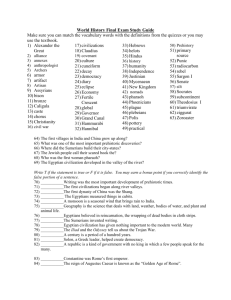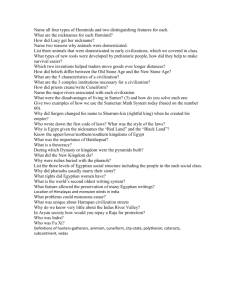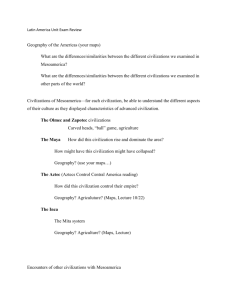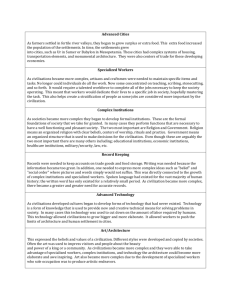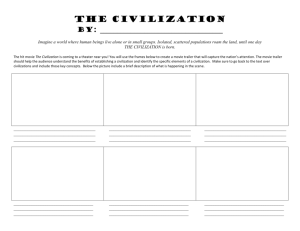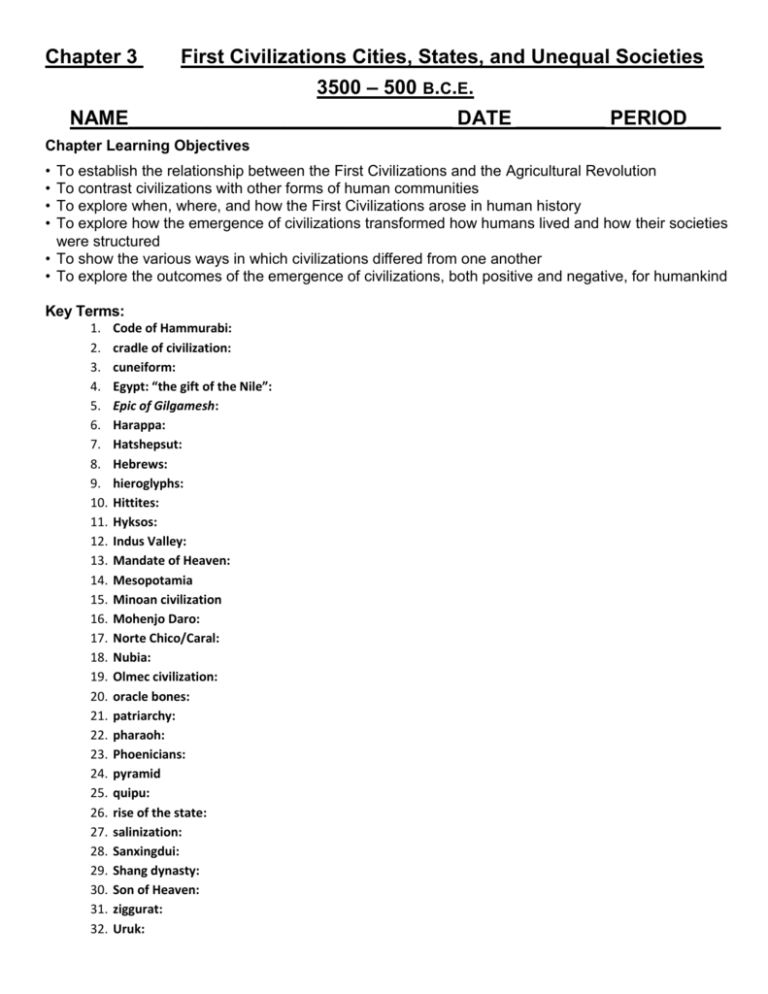
Chapter 3
First Civilizations Cities, States, and Unequal Societies
3500 – 500 B.C.E.
NAME_____________________________ DATE ________ PERIOD___
Chapter Learning Objectives
•
•
•
•
To establish the relationship between the First Civilizations and the Agricultural Revolution
To contrast civilizations with other forms of human communities
To explore when, where, and how the First Civilizations arose in human history
To explore how the emergence of civilizations transformed how humans lived and how their societies
were structured
• To show the various ways in which civilizations differed from one another
• To explore the outcomes of the emergence of civilizations, both positive and negative, for humankind
Key Terms:
1.
2.
3.
4.
5.
6.
7.
8.
9.
10.
11.
12.
13.
14.
15.
16.
17.
18.
19.
20.
21.
22.
23.
24.
25.
26.
27.
28.
29.
30.
31.
32.
Code of Hammurabi:
cradle of civilization:
cuneiform:
Egypt: “the gift of the Nile”:
Epic of Gilgamesh:
Harappa:
Hatshepsut:
Hebrews:
hieroglyphs:
Hittites:
Hyksos:
Indus Valley:
Mandate of Heaven:
Mesopotamia
Minoan civilization
Mohenjo Daro:
Norte Chico/Caral:
Nubia:
Olmec civilization:
oracle bones:
patriarchy:
pharaoh:
Phoenicians:
pyramid
quipu:
rise of the state:
salinization:
Sanxingdui:
Shang dynasty:
Son of Heaven:
ziggurat:
Uruk:
33. Xia dynasty
34. Zhou dynasty:
35. Teotihuacán:
Multiple Answer Questions
The questions here are intended to call your attention to significant topics dealt with in the textbook. You
can use them to test your recall of what you have read. More important, you can use them to guide your
thinking about what you should get from your reading.
For each question there may be more than one correct answer.
1.The student of history can tell that a society has moved beyond the Neolithic stage of pre-civilization and
entered the stage of civilization by evidence that it had
a. literacy.
b. urban settlement.
c. language.
d. monotheistic religion
2.The student of history can tell that a society has moved beyond the Neolithic stage of precivilization and
entered the stage of civilization by evidence that it had
a. metal working.
b. religion.
c. agriculture.
d. governing classes.
3. On the basis of current knowledge, historians conclude that the first civilized people in the world were
a. in Africa.
b. Semitic.
c. Mesopotamians.
d. Sumerians.
4. The civilizations that emerged independently in the first phase of the "First Civilizations" (approximately
3500 B.C. to 2500 B.C.) were located in
a. northeast Africa.
b. south Asia.
c. southwest Asia.
d. western South America
5. The geographical region in which the very first civilization developed was
a. the place where agriculture first developed.
b. a river valley with annual floods.
c. characterized by often violent flooding of the rivers.
d. an area of abundant rainfall.
6. The geographical conditions in which Egyptian civilization emerged included
a. rich agricultural soil renewed by annual flooding.
b. sufficient annual rainfall for successful agriculture.
c. desert regions protecting Egypt from easy invasion.
d. sandy soil that required the farmers to learn how to fertilize before they could succeed.
7. The first civilization of South America developed in
a. a mountainous region.
b. the lush valley of the Amazon river.
c. an area of low average annual rainfall.
d. modern-day Venezuela.
8. The civilizations that emerged independently in the second phase of the "First Civilizations"
(approximately 2500 B.C. to 1200 B.C.) were located in
a. southwest Asia.
b. south Asia.
c. Mesoamerica.
d. east Asia.
9. Civilization emerged in south Asia in the
a. fertile valley of the Ganges river.
b. semi-arid valley of the Indus river.
c. Deccan plateau.
d. marshy delta of the Ganges.
10. The area in which civilization first emerged in China
a. was the well-watered Yangtze river valley in southern China.
b. receives little rainfall but has fertile soil.
c. has a predictable annual flood, like the area in which Egyptian civilization emerged.
d. is the valley of the Yellow river called "China's Sorrow."
11. According to Chinese tradition, the first dynasty of the succession of Chinese dynasties was
a. the Shang.
b. created by King Wen.
c. created by King Yu the Great.
d. set up by someone who organized flood-control projects.
12. The writing system of the Sumerian civilization was
a. hieroglyphics.
b. pictographic.
c. cuneiform.
d. alphabetic.
13. Writing in the Indus Harappan civilization
a. was much like Sumerian cuneiform.
b. was Egyptian-style hieroglyphics.
c. did not exist, as was also the case in the Andean civilization.
d. consisted of short pictograph inscriptions.
14. The writing system of the Harappan civilization
a. proves that the Harappan people were civilized.
b. has not yet been figured out by scholars.
c. is closely related to the earliest system that developed in the Americas.
d. was devised in order to communicate with dead ancestors.
15. The religion of the pre-Aryan Indus civilization appears to have included
a. careful burial practices .
b. respect for the bull.
c. a female nature deity.
d. ritual bathing.
16. The system of writing that developed in China during the Shang dynasty
a. was so complex that it restricted greatly the number of literate persons.
b. allowed people who could not understand each other's spoken language to communicate intelligibly.
c. used a highly sophisticated alphabet.
d. consisted of various types of graphs (symbols).
17. We can conclude that Olmec society in Mesoamericaqualifies as a civilization because it had
a. slaves.
b. cities.
c. religion.
d. writing.
18. The American Olmec writing system
a. used an alphabet like that of the Hebrews.
b. was pictographic.
c. contains hieroglyphic figures similar to those of the Nubians.
d. has not yet been deciphered by modern scholars.
19. The Sumerian civilization legitimized the rulers' authority on the principle that they
a. ran the irrigation system effectively.
b. were the most successful military commanders.
c. were the descendants of divinities.
d. were the chosen agents of god.
20. The Egyptian civilization legitimized the rulers' authority on the principle that they
a. ran the irrigation system effectively.
b. were the most successful military commanders.
c. were the descendants of divinities.
d. were the chosen agents of god.
21. The legitimizing ideology of the Zhou dynasty in China explained that the king had the right to rule
because he
a. was a direct descendant of a god.
b. maintained respectful relations with dead ancestors.
c. had been granted the Mandate of Heaven.
d. lived a life of virtue.
22. According to the traditional Chinese doctrine of the "Mandate of Heaven"
a. the emperor is divine.
b. the Chinese are a divinely chosen people.
c. dynasties that are not virtuous will be overthrown.
d. dynasties change but the Chinese state system remains in place.
23. The huge stone heads of the Olmec civilization show that it
a. used a naturalistic art style.
b. was imported from Africa
c. used iron tools
d. practiced human sacrifice
24. The Sumerian religious system was characterized by
a. practices to win benefits from the gods.
b. principles for living a good life.
c. rituals by which to attain eternal life.
d. belief in reincarnation.
25. Mesopotamian religion taught that the gods
a. were associated with natural phenomena.
b. punished humans for bad behavior in the after life.
c. often were frivolous, quarrelsome, and childish.
d. reward humans for good behavior in the after life.
26. The religion of Egyptian civilization differed from that of Mesopotamian civilization in that generally in
Egyptian religion
a. priests were subordinate to the monarch.
b. the gods were imagined to expect moral behavior by humans.
c. there was a chief, or great god.
d. the gods were imagined to act mischievously and capriciously.
27. The role of the story of Gilgamesh in ancient Mesopotamian culture was to
a. promote belief in the king's divinity.
b. teach people how to live moral lives.
c. show that it is impossible for a person to achieve immortality.
d. reflect the position of male superiority in gender relations.
28. In the Mesopotamian Epic of Gilgamesh Gilgamesh
a. refused Inanna's attempts to seduce him sexually.
b. symbolized how the patriarchy of civilization replaced Neolithic matriarchy.
c. met the only man to survive a worldwide flood.
d. learned that people cannot live forever.
29. According to the Mesopotamian Epic of Gilgamesh the gods decided to destroy all human life in a
worldwide flood because humans
a. refused to make sacrifices to them.
b. committed too many sins.
c. were finding out the secrets of living forever.
d. made too much noise.
30. The role of the story of Osiris in ancient Egyptian religion was to
a. promote belief in the pharaoh's divinity.
b. permit the people to maintain a sun cult.
c. strengthen the belief in the possibility of achieving immortality.
d. reflect the position of male superiority in gender relations.
31. Which, if any, of the following statements correctly describe Egyptian civilization?
a. All religious and political power was united in the pharaoh
b. No law codes were necessary in Egypt; the pharaoh was the direct source of law and justice
c. People obeyed the pharaoh primarily because of his overwhelming military force
d. People believed they could achieve eternal life by living a moral life.
32. Hammurabi's Babylonian Code of Laws reflected
a. an "eye for an eye" philosophy.
b. a society with little social hierarchy.
c. a belief in social justice.
d. the belief that might makes right.
33. The fundamental principle of the Code of Hammurabi, represented by the phrase "an eye for an eye,
tooth for a tooth," was
a. revenge.
b. fairness in punishment.
c. elimination of capriciousness in punishment.
d. cruel and unusual punishment.
34. "Justice," according to Hammurabi's Code of Laws, means that
a. the seriousness of a crime depends on the status of the person offended by the crime.
b. punishments must be proportionate to the seriousness of crimes committed.
c. punishments must be the same for all people who commit the same crime.
d. all persons must be subject to all the laws of a society.
35. In the middle of the 1600s B.C. Egypt was invaded by people who
a. advanced up the Nile from Africa.
b. brought to Egypt the technology of bronze making.
c. introduced the military technology of the horse-drawn chariot.
d. introduced monotheistic beliefs to Egyptian civilization.
36. The Hyksos who took over Egypt in the seventeenth century B.C.
a. were Semitic invaders.
b. introduced iron weapons to Egypt.
c. forced monotheism onto polytheistic Egypt.
d. were expelled by Egyptian leaders named Moses.
37. Egyptian civilization shared with societies further south in Africa
a. a preference for matrilineal descent.
b. the practice of circumcision.
c. gods that were depicted as animals.
d. belief that the ruling monarch was divine.
38. Which of the following features of Nubian culture probably appeared earlier in Nubia than in Egypt?
a. agriculture.
b. alphabet.
c. iron production.
d. centralized, deified kingship.
39. The people known as "Israelites" contributed to world civilization the concepts of
a. monotheism.
b. alphabetic writing.
c. eye-for-eye justice.
d. historical truth-telling.
40. Which, if any, of the following statements correctly describe the Israelite God?
a. He was believed to be universal, not merely Hebrew.
b. He was believed to have directed the Hebrews to take control of the area of Canaan.
c. He was conceived to be not a natural force but rather a man.
d. He was believed to be capricious in his dealings with human beings.
41. The Phoenicians lived
a. in a powerful empire between Mesopotamia and Egypt .
b. on islands between Greece and Turkey.
c. in city-states along the east Mediterranean coast.
d. in the deserts along the Red Sea
42. In the evolution of civilization's activity, the people known as "Phoenicians" engaged especially in the
actions of
a. law-code development
b. overseas expansion.
c. alphabetic writing.
d. metallurgical innovation.
43. Which, if any, of the following correctly state how the Phoenicians earned their place in history?
a. They were the most important colonizers in the Mediterranean before the Greeks.
b. They were the first people to use an alphabet.
c. They were the first to spread the use of iron in the Middle East.
d. They created the city of Carthage.
44. The innovations in the ancient Middle East for which the Hittites were responsible included
a. the alphabet.
b. iron weapons.
c. horse-drawn vehicles.
d. coinage.
Study guide prepared by Paul D. Steeves; all rights reserved
MARGIN REVIEW QUESTIONS
1.
2.
3.
4.
5.
6.
7.
8.
9.
What were the sources of state authority in the First Civilizations?
In what ways did Mesopotamian and Egyptian civilizations differ from each other?
When and where did the First Civilizations emerge?
What was the role of cities in the early civilizations?
What accounts for the initial breakthroughs to civilization?
In what ways was social inequality expressed in early civilizations?
In what ways have historians tried to explain the origins of patriarchy?
How did Mesopotamian and Egyptian patriarchy differ from each other?
In what ways were Mesopotamian and Egyptian civilizations shaped by their interactions with
near and distant neighbors?
BIG PICTURE QUESTIONS
ATLEAST A PARAGRAPH PER QUESTION!!!!!
EXPLAIN!
EXPAND!
USE EXAMPLES FROM TEXT!
1. What distinguished civilizations from other forms of human community?
2. How does the use of the term “civilization” by historians differ from that of popular usage? How
do you use the term?
3. “Civilizations were held together largely by force.” Do you agree with this assessment, or were
there other mechanisms of integration as well?
4. In the development of the First Civilizations, what was gained for humankind, and what was
lost?

